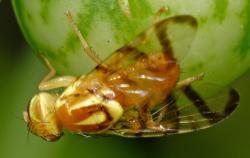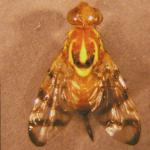Pepper Maggot
Zonosemata electa
 Pepper maggot is a fly pest that is closely related to apple maggot and has one generation per year. The larvae feed only on solanaceous plants, including ground cherry, horse nettle, tomato, pepper, and eggplant. Pepper is the preferred host, and green bell peppers and cherry peppers are especially susceptible. Because flies lay eggs directly into pepper fruit, the damage often goes unseen until it is too late. The pepper maggot fly is found throughout eastern North America. Activity of this pest is very localized and varies by farm, region, and year. Many farms never have a problem with this pest. Other farms may have it without realizing, because it is possible to confuse maggot damage with damage caused by ECB. The best way to detect activity early on is to look for stings on the fruit, and these are easiest to spot on cherry peppers.
Pepper maggot is a fly pest that is closely related to apple maggot and has one generation per year. The larvae feed only on solanaceous plants, including ground cherry, horse nettle, tomato, pepper, and eggplant. Pepper is the preferred host, and green bell peppers and cherry peppers are especially susceptible. Because flies lay eggs directly into pepper fruit, the damage often goes unseen until it is too late. The pepper maggot fly is found throughout eastern North America. Activity of this pest is very localized and varies by farm, region, and year. Many farms never have a problem with this pest. Other farms may have it without realizing, because it is possible to confuse maggot damage with damage caused by ECB. The best way to detect activity early on is to look for stings on the fruit, and these are easiest to spot on cherry peppers.
Life Cycle & Identification:
 Adult pepper maggot flies are bright yellow and smaller than a house fly, with three yellow stripes on the thorax, green eyes, and clear wings with a distinct banding pattern. Adults emerge in mid-July and aggregate in forested field edges to mate, then enter the field during the day to lay their eggs in pepper fruit. Eggs are light-colored and about 2 mm in length, making them difficult to find inside of fruit. After about 10 days, white maggots hatch from these eggs and tunnel into the fruit, growing to about ½ inch in length over a period of about two weeks. They do not have a distinct head capsule, unlike ECB larvae which have brown head capsules. In late August or early September, the maggot exits at the blossom end of the fruit and pupates in the soil, overwintering as a pupa before emerging the following spring as an adult where last year's host plants were.
Adult pepper maggot flies are bright yellow and smaller than a house fly, with three yellow stripes on the thorax, green eyes, and clear wings with a distinct banding pattern. Adults emerge in mid-July and aggregate in forested field edges to mate, then enter the field during the day to lay their eggs in pepper fruit. Eggs are light-colored and about 2 mm in length, making them difficult to find inside of fruit. After about 10 days, white maggots hatch from these eggs and tunnel into the fruit, growing to about ½ inch in length over a period of about two weeks. They do not have a distinct head capsule, unlike ECB larvae which have brown head capsules. In late August or early September, the maggot exits at the blossom end of the fruit and pupates in the soil, overwintering as a pupa before emerging the following spring as an adult where last year's host plants were.
Damage:
Females insert eggs directly into immature pepper fruit, leaving a small dimple called an oviposition sting or scar. There may be several oviposition scars on a single fruit. Pepper maggots tunnel within the fruit, especially in the placenta (the spongy white tissue inside the pepper that the seeds are attached to). This results in soft spots on fruit walls and brown mines within. Maggots also leave tiny round exit holes in fruit as they make their way out to pupate. These holes allow for the entry of soft rot bacteria into the fruit. Sometimes, the oval brown pupae can be found inside the fruit. Damage is often only detected because of premature ripening or decay of the fruit, or fruit filling with water via the exit holes during washing or hydrocooling.
Monitoring & Thresholds:
 Capturing pepper maggot flies is an effective but largely impractical method of detection, requiring yellow sticky traps be baited with a vial of 28% ammonium hydroxide and placed 20 feet up in maple trees along hedgerows. A simpler way to monitor for fly activity is by scouting their preferred crops for oviposition scars—the marks left by egg-laying females. The flies prefer to lay eggs in the small (1-3 cm in diameter) round fruit of cherry peppers, and when planted in border rows around a pepper crop, these work very well as indicator plants. If cherry peppers are not part of your crop mix, look for stings on bell peppers—these are their second favorite type of pepper. By timing insecticide applications with the first occurrence of the stings on the indicator plants’ fruit, damage to the main crop can be avoided with minimal spraying.
Capturing pepper maggot flies is an effective but largely impractical method of detection, requiring yellow sticky traps be baited with a vial of 28% ammonium hydroxide and placed 20 feet up in maple trees along hedgerows. A simpler way to monitor for fly activity is by scouting their preferred crops for oviposition scars—the marks left by egg-laying females. The flies prefer to lay eggs in the small (1-3 cm in diameter) round fruit of cherry peppers, and when planted in border rows around a pepper crop, these work very well as indicator plants. If cherry peppers are not part of your crop mix, look for stings on bell peppers—these are their second favorite type of pepper. By timing insecticide applications with the first occurrence of the stings on the indicator plants’ fruit, damage to the main crop can be avoided with minimal spraying.
If this pest is a concern for your farm, consider using perimeter trap cropping. Plant one row of cherry peppers around the perimeter of the crop. These peppers are more attractive to the maggot flies than the sweet bells, so the flies will build up in the perimeter, allowing for a perimeter spray that will reduce pest populations and protect the main crop. Perimeter trap crop systems can be as effective as whole field sprays while drastically reducing pesticide costs.
Cultural Control:
Since pepper maggot builds up on particular farms or fields rather than spreading out far and wide, you can make an impact on the population size on your farm over time by using cultural practices.
- Disc and plow pepper residue as soon as harvest is complete to kill larvae and pupae.
- Rotate peppers far from last year’s crop.
- Control solanaceous weeds, especially horsenettle.
- Cover the pepper crop with insect netting during egg-laying (beginning in mid-/late- July).
- Remove infested and/or rotting fruit from field at each harvest and destroy (e.g. by feeding to pigs or chickens or burying deeply in a compost or cull pile). This will remove larvae and pupae from the field too.
- Use plastic mulch and/or weedmat as barrier to prevent larvae from reaching the soil to pupate. Instead, they will get cooked on the mulch or mat surface.
Chemical Control:
Farms that have never had a problem with pepper maggot generally do not need to be concerned. However, the range of this pest seems to be expanding. Chemical controls must target the adult fly because eggs and larvae are protected inside the fruit. For farms with a history of pepper maggot activity, it is recommended that an insecticide be applied as soon as adult flies are captured in sticky traps or stings are observed on fruit.
For more details and up-to-date information regarding pepper maggot control, see the Pepper Insect Management section of the New England Vegetable Management Guide.
Crops that are affected by this insect:
The Center for Agriculture, Food and the Environment and UMass Extension are equal opportunity providers and employers, United States Department of Agriculture cooperating. Contact your local Extension office for information on disability accommodations. Contact the State Center Director’s Office if you have concerns related to discrimination, 413-545-4800 or see ag.umass.edu/civil-rights-information.

